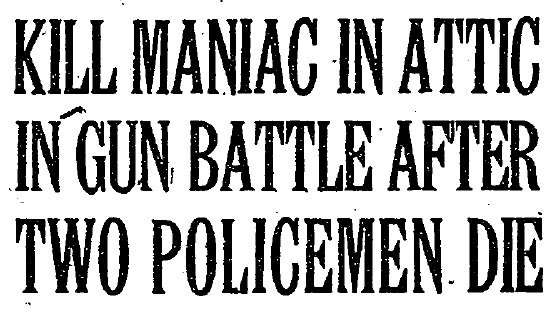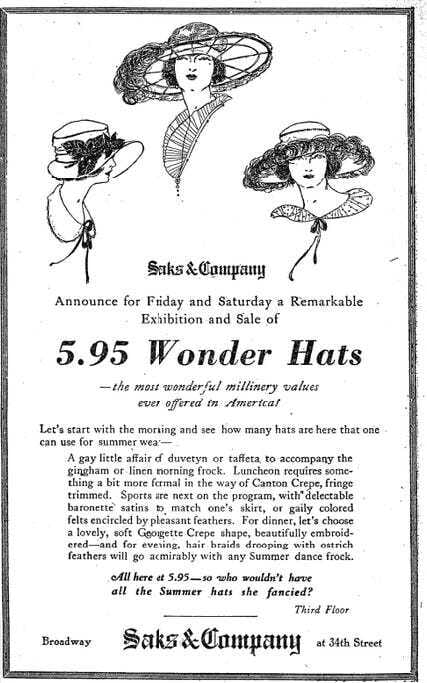- Strange Times
- Posts
- Strange Times 161: Shot Through the Heart
Strange Times 161: Shot Through the Heart
Attention bargain hunters! Westside, the thrilling first novel in the Gilda Carr trilogy, is currently on sale for just $1.99 as an ebook. Get it from Amazon or Barnes and Noble and tell your book-hungry friends to do the same!
Today we have a single story of bad decisions and machine guns. Just pay your damn landlady on…
June 10, 1921
The American consul in Liege, Belgium, seeks the parents of Mike, a 14-year-old runaway who has been drifting around Europe since January.
Henry Ford issues a statement denying rumors of his bankruptcy and Antisemitism, claiming that he is the victim of a Jewish conspiracy and insisting that, “No Jew has succeeded in getting the better of Mr. Ford.”
Four officials of the Erie Tire and Rubber Company admit to conspiring against former company president Peter F. Wills, framing him for embezzlement in order to seize control of the company.
After refusing to complete his sentence of one week’s housework, George Watson is condemned to six months in the Workhouse, leaving his wife and four children without support.
Arriving in Naples, Caruso is greeted by a throng of admirers and announces that the voyage has left him fully fit and ready to return to the stage in the fall.
The Weather: Partly cloudy today and Saturday; not much change in temperature; moderate southwest winds.

Tragedy is the result after a waiter forgets the essential lesson of every slasher movie: if you run upstairs, you’re already trapped. Run down, fool, run down!
TOLEDO, Ohio, June 9.—Like a battle front in France, Walnut and Huron Streets resounded to bursts of machine guns, the roar of repeating shotguns, the staccato bark of pistols and the crack of high-powered rifles today when the entire police and detective forces sought vengeance for the deaths of two of their comrades, Patrolman Harry Dowell and Harold Mossburger, and endeavored to rout from his barricade the maniac who had killed them.
Five thousand people, oblivious of the danger of ricocheting bullets, watched the battle which had as its cause a disagreement between John Kelley, a waiter, and Mrs. Nellie Key, the landlady of a rooming house at 611 Walnut Street, and which ended with the death of Kelley after the top floor of the house had been riddled by gun fire.
Kelley, it is said, refused to pay his board bill—an item of about $75—and when Mrs. Key remonstrated with him and called for her son, Allen Relyea, Kelley drew a revolver, threatened them and any police with death, and retreated to his room on the second floor. Mrs. Key immediately sent for the police to subdue him and when the first detachment of two men arrived a fight was on that continued for two thrilling hours.
The police received the first call about 8:30 A.M. Patrolman Mossburger and Bikupski responded from the Lagrange Street station three blocks away. When they arrived at the house they started for Kelley’s room on the second floor. He saw them and, drawing his revolver, ran to the attic.
Kills First Policeman
Mossburger started after him. Kelley turned and shot twice. Mossburger fell back on the stairs, his weight almost knocking Bikupski down. Mossburger was shot through the mouth and leg.
Bikupski ran to telephone for help and soon police began to arrive from all directions, armed with shotguns, rifles and pistols. Bikupski looked toward the attic as if to attempt an attack and a volley from Kelley’s gun drove him back.
The passage to the attic, dark and narrow, could easily be controlled by a man at the top and the police quickly realized that it could not be rushed from the inside. So they surrounded the house while detectives searched other rooms to see if Kelley had any confederates.
Patrolman Dowell, a traffic officer, took his post in front of the house armed with a shotgun. Other policemen and detectives were near at hand. Suddenly there was a cry of “Look out.” A hand was thrust through the attic window, a revolver spat and Dowell fell forward on his face, shot through the heart. Other policemen ran to him and turned him over. Again the hand was poked through the attic window, and more shots were fired, driving the officers away from Dowell’s body. While the fight continued Dowell’s body lay in the sun on the sidewalk of what constituted a “no man’s land.”
Detectives took to the roof of the house. They kicked off a skylight cover and from their position could see blood running from Mossburger’s body. With the detectives on the roof, Kelley started firing through the windows. Policemen, taking up their stations across the street, behind trees and poles, answered his fire. At this the detectives on the roof had to leave hurriedly, because the bullets from their comrades were coming too near them.
Inspector Leutz had a narrow escape from a bullet that whistled past his head in one of the attempts to reach Dowell’s body. Finally a sheet of steel was secured and, carrying it ahead of him, Police Inspector Delehaunty crept forward and fastened a rope around the leg of Dowell’s body. Then he slipped back out of danger without drawing the fire of the madman. Several citizens rushed up, grabbed the body and carried it back into the crowd.
Machine Gun Installed
Spotting Motor Patrolman Harvey Cavender, Kelley opened fire and Cavender, an army marksman, returned the shots with his shotgun, but hidden as he was behind the thick walls and shooting through tiny ventilators Kelley was well covered.
Finally a machine gun was secured from the armory with one belt of ammunition. It was placed in the attic of a house across the street and at a word from Police Captain Tom O’Rielly, its roar was added to the din of the other weapons.
To man the gun, volunteers were sought. Burr Taggart, a former army Lieutenant, and George Shanteau responded and, with Martin O’Toole, a motor policeman and ex-aviation officer; Jay Gilday, formerly First Sergeant in one of the Toledo batteries in France, and Patrolmen Carlisle and Armstrong, the gun opened fire. The bullets chopped limbs off the trees and tore holes in the brick wall below the window casing of Kelley’s barricade. Then the gun jammed. Shanteau’s thumb was burned from holding the hot weapon. Carlisle produced a button hook, and with this the defective cartridge was extricated from the magazine. Two shots were fired from the window by Kelley after the first machine-gun burst.
Safety Director Greenhalgh arrived on the scene. It was suggested that high pressure water mains be used to batter down the walls, but Fire Chief Elling said that the hose would have to be brought close to the building, thus exposing the firemen to Kelley’s fire.
When the final bursts from the machine gun tore bigger holes in the brick building, the police put down a formaldehyde attack through the roof.
Kelley made no response, and the detectives and police rushed into his room, expecting at any minute to hear his revolver roar. They stumbled over the stairs, and when they entered the room they found Kelley dead on the bed with his revolver in his left hand. He was hit twice, evidently by machine gun bullets. His revolver was fully loaded, as was the gun of Patrolman Mossburger, which Kelley had appropriated along with the ammunition of the dead policeman. This disproved the theory that Kelley might have killed himself.
When the cry “They’ve got him” went up from the police on the outside it was taken up by the thousands of spectators in the street. The people rushed forward, crying for the life of the man who had slain the two policeman. If Kelley had been captured alive it is doubtful whether the police would have got him away from the scene of the shooting, so enraged were the people.
With gun butts the police beat back the crowd and, led by Captain Jennings, in civilian clothes, Kelley’s body was carried to the patrol wagon and taken away.
Kelley was a mysterious individual. He was a sufferer from tuberculosis and was known for his religious mania. Police say that he had been a speaker on anarchy and other radical cults, also that more than a year ago when arrested as a suspicious person he was found to possess drugs and implements of the trade. Police also declare that he was under suspicion as a hold-up man.



